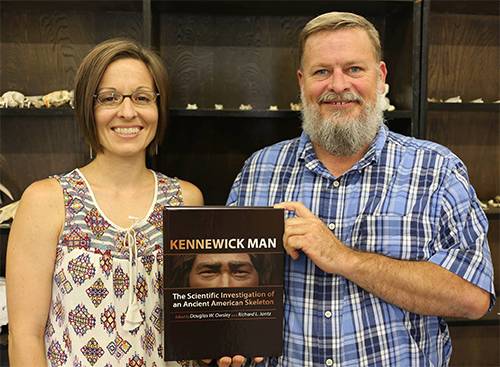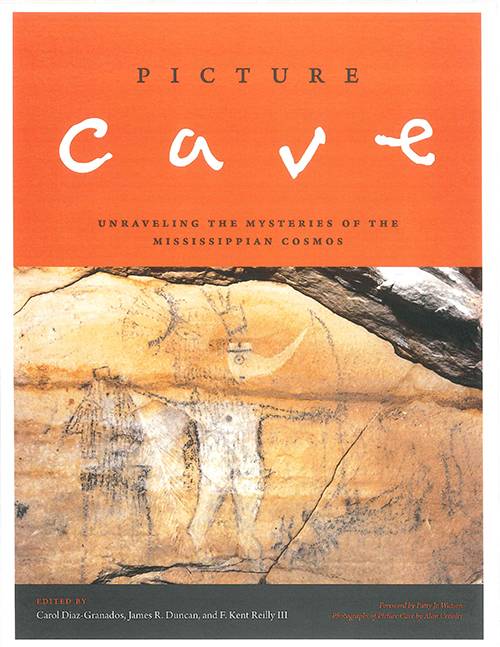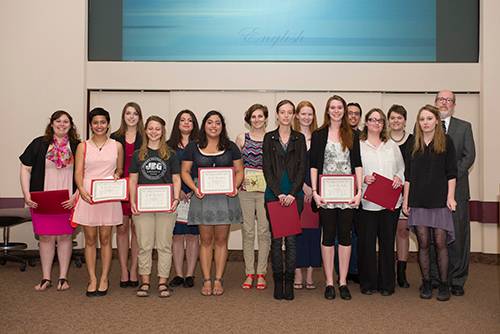Anthropology News Archive | 2014
-
News | 2014
-
Congratulations Dr. Nicole Taylor!
Congratulations to Dr. Nicole Taylor whose book, Schooled on Fat, was named a finalist for the New Mexico-Arizona Book Awards!
-
Congratulations to Dr. Kent Reilly and Jesse Nowak
Dr. Kent Reilly was recently selected by the prestigious Gilcrease Museum to serve as Guest Curator for their NEH supported exhibition on the Spiro Mounds, which will open in October 2017. The Spiro people created a powerful religious and political center in eastern Oklahoma. The mounds are dated between the 800s and 1400s CE and the burial chambers contain some of the most extraordinary pre-Columbian artifacts ever found in North America. This is a wonderful opportunity for Kent and it's a real honor that he was chosen.
Dr. Reilly's graduate student Jesse Nowak was also hired as a two-year post-graduate fellow at the Museum. Jesse will be working on grant titled "Native Artists and Scholars Bring Past to Present: Multi-Disciplinary Perspectives for Mississippian Culture Pottery."
-
Nicole Crowe receives SURF grant
Congratulations to Nicole Crowe who received a SURF grant to do histological research on sexual dimorphism in bone microstructure.
-
Texas State Anthropologists Contribute to the Investigation of Kennewick Man
 The long awaited scientific analyses of Kennewick Man, first discovered in 1996 and described as the most important human skeleton ever found in North America, have finally been published in an edited volume called Kennewick Man: The Scientific Investigation of an Ancient American Skeleton through Texas A&M Press. Drs. Kate Spradley and Daniel Wescott from the Department of Anthropology at Texas State University were part of the scientific investigation team and are contributing authors in the new book edited by Drs. Douglas Owsley of the Smithsonian Institution and Richard Jantz of the University of Tennessee. Kennewick Man is an approximately 9,000 year old skeleton found in Washington State’s Columbia River Valley that has helped unlock secrets about where the first Americans came from and how they lived their lives. Using geomorphometric analyses, Dr. Spradley found that Kennewick Man falls outside the range of variation of Archaic and Historic Native Americans, meaning that the New World was likely populated through multiple migrations. Dr. Wescott investigated the effects of Kennewick Man’s lifestyle on his bones. Using computed tomography scans and beam analyses of the long bones, Wescott’s results show that Kennewick man likely speared seal and other large marine mammals while walking over rugged coastal terrain.
The long awaited scientific analyses of Kennewick Man, first discovered in 1996 and described as the most important human skeleton ever found in North America, have finally been published in an edited volume called Kennewick Man: The Scientific Investigation of an Ancient American Skeleton through Texas A&M Press. Drs. Kate Spradley and Daniel Wescott from the Department of Anthropology at Texas State University were part of the scientific investigation team and are contributing authors in the new book edited by Drs. Douglas Owsley of the Smithsonian Institution and Richard Jantz of the University of Tennessee. Kennewick Man is an approximately 9,000 year old skeleton found in Washington State’s Columbia River Valley that has helped unlock secrets about where the first Americans came from and how they lived their lives. Using geomorphometric analyses, Dr. Spradley found that Kennewick Man falls outside the range of variation of Archaic and Historic Native Americans, meaning that the New World was likely populated through multiple migrations. Dr. Wescott investigated the effects of Kennewick Man’s lifestyle on his bones. Using computed tomography scans and beam analyses of the long bones, Wescott’s results show that Kennewick man likely speared seal and other large marine mammals while walking over rugged coastal terrain.Dr. Douglas Owsley, Division Head of Physical Anthropology at the Smithsonian’s National Museum of Natural History and lead scientific investigator of Kennewick Man, will give a lecture about the skeletal finding of Kennewick Man as well as the well-known Horn Shelter skeletons from Texas at the Texas Archaeological Society on October 25, 7:00 pm at the Embassy Suites in San Marcos. He will discuss the numerous methods for analyzing the skeleton and how they were used to solve questions about Kennewick Man’s lifestyle, diet, and origins.
-
Picture Cave: Unraveling the Mysteries of the Mississippian Cosmos
 Congratulations to Dr. Kent Reilly and his co-editors on their newest edtied book on Mississippian iconography and archaeology, "Picture Cave: Unraveling the Mysteries of the Mississippian Cosmos," which is due out in the spring.
Congratulations to Dr. Kent Reilly and his co-editors on their newest edtied book on Mississippian iconography and archaeology, "Picture Cave: Unraveling the Mysteries of the Mississippian Cosmos," which is due out in the spring. -
Eagle Nest Canyon
The Summer 2014 issue of Hillviews has arrived with the lead article written by Dr. Steve Black on the work of his team and Dr. Carolyn Boyd in Eagle Nest Canyon.
-
Congratulations Bita Razavimaleki
Bita Razavimaleki (mentor Dr. Richard Warms) has been hired as one of two, research assistant interns by the THECB. She'll be working with Nina Wright, who worked in the Dean's Office in our College years ago.
-
Faculty Accomplishments
Dr. Kent Reilly has been appointed to the University of Alabama Museums Board of Regents. You many also remember that Kent was very involved in the redesign of the Moundville Museum, the “Lost Realm of the Black Warrior.”
Dr. Mike Collins and the Gault Archaeological Project are featured in magazine Archaeology in “Who Were the First Americans.” It’s a very nice article and I hope you’ll read it.
Dr. Kate Spradley and her colleagues at Baylor University and Indiana University have positively identified and repatriated the remains of one of the border crossers recovered from Brooks County last summer. We now know Operation ID case 0425 are the remains of Maria Albertina Guardado, who had been missing since June 2012. Here is a link to the Telemundo news story that includes an interview with Mimi Doretti of the Argentine Forensic Anthropology Team and Senora Guardado’s family. The Operation ID team has another pending identification.
-
Liberal Arts Awards
On April 10, 2014, the Department of Anthropology and College of Liberal Arts honored 32 anthropology undergraduates who were awarded Academic Excellence Certificates. The anthropology faculty chose Mallory Marcone as the Department’s Outstanding Undergraduate Student. Anthropology graduate student Lennon Bates won the Outstanding Graduate Student in the College of Liberal Arts Award, which is the second time since starting our MA program in 2004 that one of our students was honored with this distinction. Congratulations to all!


-
Professor Norm Whalen honored at international conference on Saudi Arabia
A display celebrating the life and work of Norman Whalen, whose academic career studying the Palaeolithic of Arabia began after a decorated military career in WWII, and two decades as a priest in the US State of Arizona. In Saudi Arabia, Whalen worked closely with the Saudi Arabian Department of Antiquities and Museums, studying and publishing key 'early man' sites, such as Shuwayhittiyah and Dawadmi. In the 1980s, he synthesised his fieldwork in Saudi Arabia, Yemen, Oman, and Jordan to focus on migration out of Africa, making technological links with classic East African sites. Whalen’s pioneering fieldwork and publications have laid a strong foundation for future Palaeolithic work in the Arabian Peninsula, yet his work has not been widely recognised in the international literature.
-
Dr. Ana Juarez in the news
Dr. Ana Juárez's work on Mexican-American cemeteries is featured in the latest issue of the Texas Historical Commission's publication Medallion with discussion from Jennifer McWilliams (anthropology alum) who is the coordinator for the THC's Cemetery Preservation Program. Amy Reid from CAS is also mentioned in the article.
-
Dr. Kate Spradley and Ileene Vicencio in the news
KRGV did a story on Dr. Kate Spradley and undergraduate student Lleene Vicencio, discussing identifying the remains of border crossers.
-
